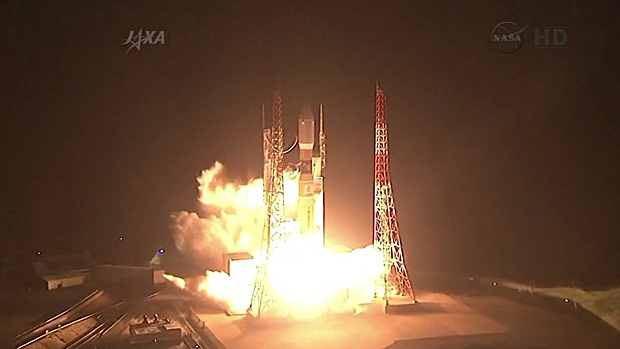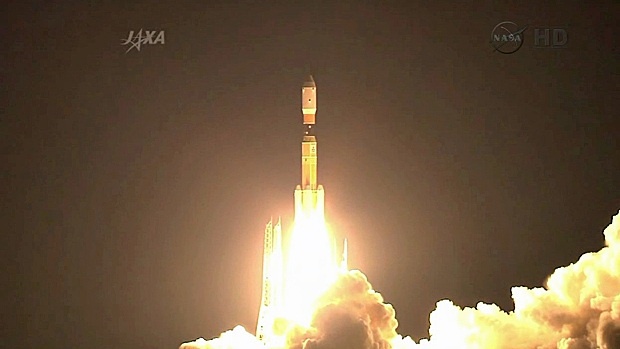Japanese cargo ship launched on station resupply flight
08/03/2013 04:10 PM Filed in: Space News | International Space Station
By WILLIAM HARWOOD
CBS News
An unmanned Japanese cargo ship loaded with nearly 4 tons of science gear, spare parts and supplies rocketed away from the Tanegashima Space Center in southern Japan Saturday, kicking off a six-day flight to the International Space Station.
With its twin hydrogen-fueled first stage engines roaring at full throttle, four strap-on solid-fuel boosters ignited with a burst of flame at 3:48:46 p.m. EDT (4:48 a.m. Sunday local time), instantly pushing the 186-foot-tall rocket away from its seaside launching stand.
Lighting up the pre-dawn sky, the rocket briefly climbed straight up trailing a brilliant jet of flame from its strap-on boosters before arcing away on a southeasterly trajectory, visible for miles around as it rapidly accelerated through a clear sky.
The space station's crew watched the launch via television beamed up from mission control in Houston.
The ascent went smoothly and the strap-on boosters burned out and fell away in pairs about two minutes after liftoff. The H-2B's first stage shut down and fell away about four minutes later and the rocket's second stage continued the push to orbit for another nine minutes.
"The flight goes very smoothly," a Japanese commentator said as the rocket neared orbit.
There were no obvious problems and about 15 minutes after liftoff from launch pad No. 2, the HTV-4 cargo ship was released into its planned preliminary orbit with a high point, or apogee, of around 186 miles and a low point, or perigee, of about 124 miles.
If all goes well, the spacecraft will carry out a carefully orchestrated sequence of rocket firings over the next several days to set up a rendezvous with the International Space Station early Friday, closing to within about 90 feet around 6:33 a.m.
At that point, with Italian astronaut Luca Parmitano monitoring the HTV's systems, the cargo ship will go into stationkeeping mode and astronaut Karen Nyberg, operating the space station's robot arm, will lock onto a grapple fixture around 7:29 a.m.
Assisted by Christopher Cassidy, Nyberg plans to move the HTV-4 spacecraft to the Earth-facing port of the station's forward Harmony module where it will be locked into place with a common berthing mechanism. Hatches will be opened the next day.
Developed by the Japan Aerospace Exploration Agency, or JAXA, as a contribution to the space station program, the HTV is 32 feet long and 14.4 feet wide. It is designed to carry both pressurized and unpressurized cargo, including equipment too big to pass through the space station's hatches.
For its fourth flight to the International Space Station, the pressurized section of the HTV is carrying an experiment sample freezer, spacesuit oxygen tanks, batteries, a spare emergency jet backpack, food for the station crew, clothing and fresh water.
The pressurized section also houses a re-entry data recorder, an ultra high-resolution camera that will be used to image Comet ISON and four small Cubesat satellites that will be deployed from the Japanese Kibo laboratory's airlock.
The HTV's unpressurized section is carrying a 516-pound main bus switching unit, part of the station's electrical power distribution system, a spare 644-pound solar array power and data interface unit and a 721-pound NASA experiment pallet housing eight experiments in a variety of disciplines.
The unpressurized components will be removed by the station's robot arm and mounted in an external logistics pallet. Cargo and supplies in the pressurized section will be unloaded by the station crew.
The astronauts then will repack the craft with trash and other no-longer needed gear. If all goes well, the HTV-4 spacecraft will be detached from the station Sept. 4, burning up in the atmosphere the next day.
Here is a timeline of critical mission events (times approximate; in EDT and mission elapsed time):
CBS News
An unmanned Japanese cargo ship loaded with nearly 4 tons of science gear, spare parts and supplies rocketed away from the Tanegashima Space Center in southern Japan Saturday, kicking off a six-day flight to the International Space Station.
With its twin hydrogen-fueled first stage engines roaring at full throttle, four strap-on solid-fuel boosters ignited with a burst of flame at 3:48:46 p.m. EDT (4:48 a.m. Sunday local time), instantly pushing the 186-foot-tall rocket away from its seaside launching stand.
 |
| A Japanese H-2B rocket blasted off from the Tanegashima Space Center in southern Japan early Sunday (Japan time), boosting the HTV-4 cargo craft into space for a flight to the International Space Station. (Photo: NASA TV) |
Lighting up the pre-dawn sky, the rocket briefly climbed straight up trailing a brilliant jet of flame from its strap-on boosters before arcing away on a southeasterly trajectory, visible for miles around as it rapidly accelerated through a clear sky.
The space station's crew watched the launch via television beamed up from mission control in Houston.
The ascent went smoothly and the strap-on boosters burned out and fell away in pairs about two minutes after liftoff. The H-2B's first stage shut down and fell away about four minutes later and the rocket's second stage continued the push to orbit for another nine minutes.
"The flight goes very smoothly," a Japanese commentator said as the rocket neared orbit.
There were no obvious problems and about 15 minutes after liftoff from launch pad No. 2, the HTV-4 cargo ship was released into its planned preliminary orbit with a high point, or apogee, of around 186 miles and a low point, or perigee, of about 124 miles.
If all goes well, the spacecraft will carry out a carefully orchestrated sequence of rocket firings over the next several days to set up a rendezvous with the International Space Station early Friday, closing to within about 90 feet around 6:33 a.m.
At that point, with Italian astronaut Luca Parmitano monitoring the HTV's systems, the cargo ship will go into stationkeeping mode and astronaut Karen Nyberg, operating the space station's robot arm, will lock onto a grapple fixture around 7:29 a.m.
Assisted by Christopher Cassidy, Nyberg plans to move the HTV-4 spacecraft to the Earth-facing port of the station's forward Harmony module where it will be locked into place with a common berthing mechanism. Hatches will be opened the next day.
Developed by the Japan Aerospace Exploration Agency, or JAXA, as a contribution to the space station program, the HTV is 32 feet long and 14.4 feet wide. It is designed to carry both pressurized and unpressurized cargo, including equipment too big to pass through the space station's hatches.
 |
| (Photo: NASA TV) |
For its fourth flight to the International Space Station, the pressurized section of the HTV is carrying an experiment sample freezer, spacesuit oxygen tanks, batteries, a spare emergency jet backpack, food for the station crew, clothing and fresh water.
The pressurized section also houses a re-entry data recorder, an ultra high-resolution camera that will be used to image Comet ISON and four small Cubesat satellites that will be deployed from the Japanese Kibo laboratory's airlock.
The HTV's unpressurized section is carrying a 516-pound main bus switching unit, part of the station's electrical power distribution system, a spare 644-pound solar array power and data interface unit and a 721-pound NASA experiment pallet housing eight experiments in a variety of disciplines.
The unpressurized components will be removed by the station's robot arm and mounted in an external logistics pallet. Cargo and supplies in the pressurized section will be unloaded by the station crew.
The astronauts then will repack the craft with trash and other no-longer needed gear. If all goes well, the HTV-4 spacecraft will be detached from the station Sept. 4, burning up in the atmosphere the next day.
Here is a timeline of critical mission events (times approximate; in EDT and mission elapsed time):
DATE/EDT......DD...HH...MM...SS...EVENT
08/03/13
03:48:46 PM...00...00...00...00...HTV4 Launch
04:03:39 PM...00...00...14...53...HTV4 Separation
11:19:18 PM...00...07...30...32...PM1 rendezvous rocket firing (28.99 m/s)
.
.
.
08/08/13
11:57:49 PM...05...08...09...03...Start of integrated ops
08/09/13
05:08:32 AM...05...13...19...46...Range: 500 m
05:21:51 AM...05...13...33...05...Sunrise
05:29:03 AM...05...13...40...17...Arrive at 250-meter hold point
05:44:03 AM...05...13...55...17...Yaw around start
05:54:03 AM...05...14...05...17...Yaw around complete
05:54:03 AM...05...14...05...17...Go
06:04:03 AM...05...14...15...17...Depart 250-meter hold point
06:30:17 AM...05...14...41...31...Sunset
06:33:30 AM...05...14...44...44...Arrive at 30-meter hold point
06:43:30 AM...05...14...54...44...Go
06:53:30 AM...05...15...04...44...Depart 30-meter hold point
06:54:54 AM...05...15...06...08...Sunrise
07:09:54 AM...05...15...21...08...Capture lighting window open
07:14:10 AM...05...15...25...24...Arrival at capture point (CP)
07:19:38 AM...05...15...30...52...Go
07:29:38 AM...05...15...40...52...CAPTURE
08:03:09 AM...05...16...14...23...Sunset
08:12:57 AM...05...16...24...11...Capture lighting window close
08:27:57 AM...05...16...39...11...Sunrise
08:42:57 AM...05...16...54...11...Backup lighting window open
09:36:01 AM...05...17...47...15...Sunset
09:46:00 AM...05...17...57...14...Backup lighting window close
10:01:00 AM...05...18...12...14...Sunrise